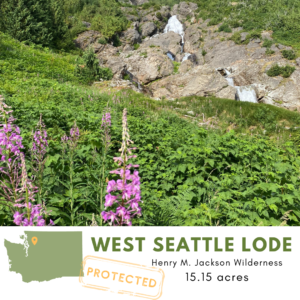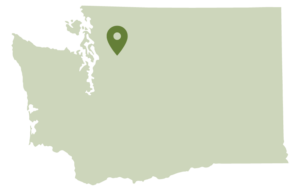June 28, 2024-
With snow melting out of the high country and summer officially upon us, field season is beginning for our lands staff. Over the next few months our team will be visiting project sites in wilderness areas across the country. Site visits are an integral part of our work: they allow us to do important due diligence on prospective properties, to plan and complete restoration work to return properties to their wilderness character before transfer to public ownership, and to meet with the private landowners and partner organizations and agencies that make our work possible. Having boots on the ground not only allows us to access the specific conservation values of each property in order to maximize our impact, the stunning vistas, wildlife sightings, and moments of solitude remind us why we do what we do.
Due to the remote nature of our project sites, each visit comes with its own set of challenges and rewards. Your support makes these visits, and in turn our work, possible.
Most Rugged  Access: Wild Sky Wilderness, Washington
Access: Wild Sky Wilderness, Washington
The Trust has protected 28 properties in the Wild Sky Wilderness, and its steep terrain coupled with the thick undergrowth of its temperate rainforest have earned them a reputation for some of the most difficult to access. The many hours of off-trail bushwhacking aren’t without payoff though, as breaks in the vegetation provide incredible views of pristine alpine lakes and craggy high-peaks. Despite the challenging access, with 15 active projects in this one wilderness area, our staff is able to visit them all relatively efficiently, and is working to transfer the majority to public ownership in one package.
 Best Company: Spring Canyon- Gila Wilderness, New Mexico
Best Company: Spring Canyon- Gila Wilderness, New Mexico
This week our staff visited the 40-acre Spring Canyon property we are working to acquire to assess its condition and characteristics. While our site visits often include partners such as agencies, local nonprofit, tribes, and technical services like appraisers and surveyors, the company on our Spring Canyon visit was notable. We visited the property with the US Forest Service on horseback, and our trusty mounts Pablo and Sino not only safely carried us across high mesas and down steep canyon walls, they brought smiles to our faces all day. Sino was recently featured in a NY Times article celebrating the centennial of the Gila Wilderness, so we were all very humbled to be in the presence of such a celebrity.
 Most Surprising Find: Wheeler Creek- Kootznoowoo Wilderness, Alaska
Most Surprising Find: Wheeler Creek- Kootznoowoo Wilderness, Alaska
Every property we work to protect has its own unique history, and oftentimes traces of that history are left behind. Our staff has found no shortage of surprising and sometimes baffling remnants deep in the wilderness, from school busses to mining equipment to metal drums full of mystery chemicals. Visiting projects to assess what restoration work will be necessary to return it to its wilderness character is an important step in our work. But the most surprising site visit find in recent memory wasn’t what we found on the property, it was finding that the property itself had grown. Throughout Southeast Alaska, as glaciers shrink the land is rising in response to the reduced weight of the glaciers in a process known as isostatic rebound. As it rises, more land is exposed above the high-water line. In completing a survey as part of our due diligence we found that the Wheeler Creek property had actually grown by less than an acre since its last survey.
 Most Likely to Need Rental Car Insurance: Cougar Canyon Wilderness, Utah
Most Likely to Need Rental Car Insurance: Cougar Canyon Wilderness, Utah
Most trips into the wilderness start with a long drive on rough roads, but some really take the cake. Having largely washed out from spring runoff, the road in to our Cougar Canyon property in SW Utah made for a particularly adventurous trip in for us and our poor rental truck on our last visit. The road forms the boundary of the wilderness area and provides access to the 700-acre property. Despite the current state of the road, in the Washington County real estate market which includes both St. George and the property (and is the fastest-growing metro area in the US) the property is highly vulnerable to development. So, to the folks at Enterprise and Hertz, you have our apologies and thanks for helping us protect this special place!
This week marks the end of our fiscal year. If you haven’t already, please consider making a donation to help fund not only our summer field season, but our work all year round.




 After the Trust acquires a private property in or around wilderness, we work with our agency partners to assess whether any restoration work is needed prior to transferring it to public ownership. Our goal is to restore the property to its wilderness character, improve habitat, and mitigate any public safety concerns on the property. What exactly that restoration looks like is different for each property, and has ranged from removing cabins, vehicles, and commercial mining equipment, to closing historic mine adits, and packing out trash.
After the Trust acquires a private property in or around wilderness, we work with our agency partners to assess whether any restoration work is needed prior to transferring it to public ownership. Our goal is to restore the property to its wilderness character, improve habitat, and mitigate any public safety concerns on the property. What exactly that restoration looks like is different for each property, and has ranged from removing cabins, vehicles, and commercial mining equipment, to closing historic mine adits, and packing out trash.


 Access: Wild Sky Wilderness, Washington
Access: Wild Sky Wilderness, Washington Best Company: Spring Canyon- Gila Wilderness, New Mexico
Best Company: Spring Canyon- Gila Wilderness, New Mexico Most Surprising Find: Wheeler Creek- Kootznoowoo Wilderness, Alaska
Most Surprising Find: Wheeler Creek- Kootznoowoo Wilderness, Alaska Most Likely to Need Rental Car Insurance: Cougar Canyon Wilderness, Utah
Most Likely to Need Rental Car Insurance: Cougar Canyon Wilderness, Utah







 In the San Jan Mountains of Colorado, southeast of the small town of Silverton, the Weminuche Wilderness covers almost half a million acres of pristine alpine habitat, including three 14,000 ft peaks. We recently completed the purchase of three parcels known as the Great Western Lode, totaling 30.96 acres. Protected within the property is a fragile community of grasses, sedges, and dwarf plants that make up Colorado’s alpine tundra. The popular 9.3 mile
In the San Jan Mountains of Colorado, southeast of the small town of Silverton, the Weminuche Wilderness covers almost half a million acres of pristine alpine habitat, including three 14,000 ft peaks. We recently completed the purchase of three parcels known as the Great Western Lode, totaling 30.96 acres. Protected within the property is a fragile community of grasses, sedges, and dwarf plants that make up Colorado’s alpine tundra. The popular 9.3 mile  The Trust recently completed the purchase of the 15.15-acre West Seattle Lode, our first acquisition in Washington’s Henry M. Jackson Wilderness. This rugged, glaciated landscape is home to the endangered Northern Spotted Owl, Cascade red fox, pika, wolverines, and Marbled Murrelet, a seabird that nests in old growth forests and alpine slopes. The property is on a steep slope that overlooks the Monte Cristo ghost town, the site of a gold and silver mining boom lasting from 1895-1912.
The Trust recently completed the purchase of the 15.15-acre West Seattle Lode, our first acquisition in Washington’s Henry M. Jackson Wilderness. This rugged, glaciated landscape is home to the endangered Northern Spotted Owl, Cascade red fox, pika, wolverines, and Marbled Murrelet, a seabird that nests in old growth forests and alpine slopes. The property is on a steep slope that overlooks the Monte Cristo ghost town, the site of a gold and silver mining boom lasting from 1895-1912. The 20-acre Jasperson Lode property was purchased by The Trust in 2017, and was recently transferred to public ownership. This newest addition to the Wild Sky Wilderness sits in a bowl on the south flank of the imposing Sheep Gap Mountain, just west of the Silver Creek drainage. With the property now incorporated into the wilderness, the patchwork of land management regulations and wildlife habitat has been removed, ensuring seamless conservation across the landscape.
The 20-acre Jasperson Lode property was purchased by The Trust in 2017, and was recently transferred to public ownership. This newest addition to the Wild Sky Wilderness sits in a bowl on the south flank of the imposing Sheep Gap Mountain, just west of the Silver Creek drainage. With the property now incorporated into the wilderness, the patchwork of land management regulations and wildlife habitat has been removed, ensuring seamless conservation across the landscape.
 November 3, 2022- This week the Wilderness Land Trust completed the purchase of the privately owned 280-acre Greater New York Lode property in Washington’s Wild Sky Wilderness.
November 3, 2022- This week the Wilderness Land Trust completed the purchase of the privately owned 280-acre Greater New York Lode property in Washington’s Wild Sky Wilderness.
